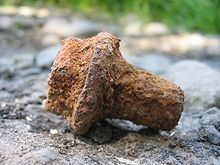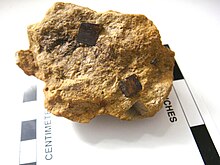IRON OXIDES IN SPACE DOTH CORRUPT
"But lay up for yourselves treasures in heaven, where neither moth nor rust doth corrupt,(Matthew 6:20)
In space There is No present of Oxygen and air moisture on that reason No possibility of oxidation that resulting rush (Iron Oxides) 2,000 Yrs before Man discovery is already revealed in the Bible that in (Space) Rush doth corrupt.
Rust is iron oxides. In colloquial usage, the term is applied to red oxides, formed by the reaction of iron and oxygen in the presence of water or air moisture. There are also other forms of rust, such as the result of the reaction of iron and chloride in an environment deprived of oxygen, such as rebar used in underwater concrete pillars, which generates green rust. Several forms of rust are distinguishable visually and by spectroscopy, and form under different circumstances. Rust consists of hydrated iron(III) oxides Fe2O3·nH2O andiron(III) oxide-hydroxide FeO(OH)·Fe(OH)3.
Given sufficient time, oxygen, and water, any iron mass will eventually convert entirely to rust and disintegrate. Surface rust provides no protection to the underlying iron, unlike the formation of patina on copper surfaces. Rusting is the common term for corrosion of iron and its alloys, such as steel. Many other metals undergo equivalent corrosion, but the resulting oxides are not commonly called rust.
Chemical reaction
When impure (cast) iron is in contact with water, oxygen, or other strong oxidants, or acids, it rusts. If salt is present, for example in seawater or salt spray, the iron tends to rust more quickly, as a result of electrochemical reactions. Iron metal is relatively unaffected by pure water or by dry oxygen. As with other metals, like aluminium, a tightly adhering oxide coating, a passivation layer, protects the bulk iron from further oxidation. The conversion of the passivating iron oxide layer to rust results from the combined action of two agents, usually oxygen and water.
Other degrading solutions are sulfur dioxide in water and carbon dioxide in water. Under these corrosive conditions, iron hydroxide species are formed. Unlike iron oxides, the hydroxides do not adhere to the bulk metal. As they form and flake off from the surface, fresh iron is exposed, and the corrosion process continues until either all of the iron is consumed or all of the oxygen, water, carbon dioxide, or sulfur dioxide in the system are removed or consumed.
Associated reactions
Associated reactions
The rusting of iron is an electrochemical process that begins with the transfer of electrons from iron to oxygen. The rate of corrosion is affected by water and accelerated by electrolytes, as illustrated by the effects of road salt on the corrosion of automobiles. The key reaction is the reduction of oxygen:
- O2 + 4 e− + 2 H2O → 4 OH−
Because it forms hydroxide ions, this process is strongly affected by the presence of acid. Indeed, the corrosion of most metals by oxygen is accelerated at low pH. Providing the electrons for the above reaction is the oxidation of iron that may be described as follows:
- Fe → Fe2+ + 2 e−
The following redox reaction also occurs in the presence of water and is crucial to the formation of rust:
- 4 Fe2+ + O2 → 4 Fe3+ + 2 O2−
In addition, the following multistep acid-base reactions affect the course of rust formation:
- Fe2+ + 2 H2O ⇌ Fe(OH)2 + 2 H+
- Fe3+ + 3 H2O ⇌ Fe(OH)3 + 3 H+
as do the following dehydration equilibria:
- Fe(OH)2 ⇌ FeO + H2O
- Fe(OH)3 ⇌ FeO(OH) + H2O
- 2 FeO(OH) ⇌ Fe2O3 + H2O
From the above equations, it is also seen that the corrosion products are dictated by the availability of water and oxygen. With limited dissolved oxygen, iron(II)-containing materials are favoured, including FeO and black lodestone (Fe3O4). High oxygen concentrations favour ferric materials with the nominal formulae Fe(OH)3-xOx/2. The nature of rust changes with time, reflecting the slow rates of the reactions of solids.
Furthermore, these complex processes are affected by the presence of other ions, such as Ca2+, both of which serve as an electrolyte, and thus accelerate rust formation, or combine with the hydroxides and oxides of iron to precipitate a variety of Ca-Fe-O-OH species.
A chemical rust indicator can be used for testing the presence of Fe2+. Fe2+ turns the rust indicator from yellow to blue.







Comments
Post a Comment